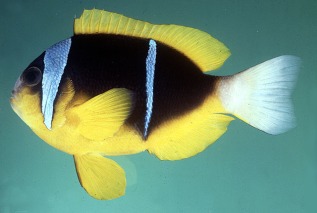Common Name: African Anemonefish
Scientific Name: Amphiprion allardi Klausewitz, 1970
Distribution: Kenya to Durban, South Africa, Bassas da India, Europa Island. Possibly at Juan de Nova Island.
Type Locality: Bamburi near Mombasa, Kenya
Identification: Two stripes; middle stripe quite thin, anterior stripe thick and widens dorsally. Body orange, but heavily darkened along sides, showing the base color only in the head and lowermost portions. Caudal fin white and lunate; juveniles with the lower edge orange. Otherwise, fins are bright orange. Pelvic fins with leading edge black.
Similar: Nearly identical to the true Amphiprion chrysopterus of Micronesia, but can be told apart by the more darkly colored head and the orange patch present on the caudal peduncle. Dark individuals of the Red Sea A. bicinctus differ primarily in their yellow caudal fin, though occasional specimens have this more clear. Amphiprion cf latifasciatus “Yellowmargin” from Southeastern Madagascar has a wider middle stripe and yellow margins to the caudal fin in adults.
Notes: The similarity between this fish and the geographically and phylogenetically distant A. chrysopterus is remarkable. It’s likely to be closest to A. cf latifasciatus “Yellowmargin”, and might be expected to hybridize with it in the poorly studied reefs of the Southern Mozambique Channel and Southeastern Madagascar. Despite its large range along the Eastern African coastline, this species shows little phenotypic variation, though there might be some genetic separation expected between northern and southern populations.
This is a reasonably common species in the aquarium trade, originating from Kenyan exporters. Named for Jack Allard, a Kenyan fish exporter who collected the first specimens.









